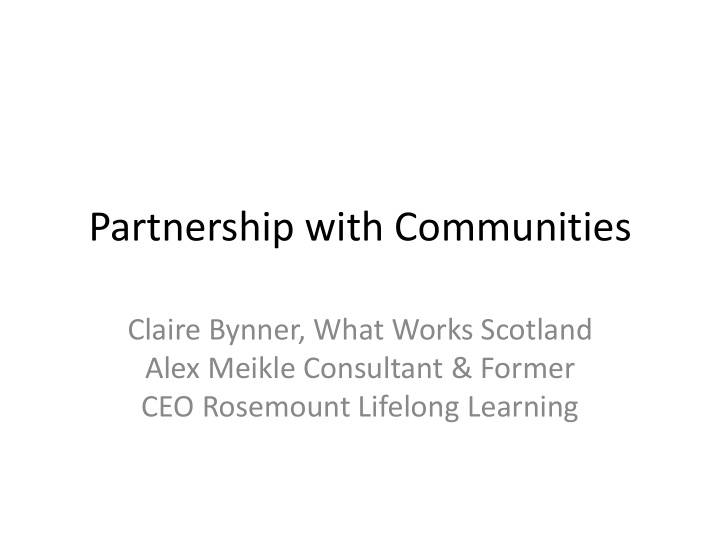



Partnership with Communities Claire Bynner, What Works Scotland Alex Meikle Consultant & Former CEO Rosemount Lifelong Learning
Aims • Critical engagement with the notion of community partnership • Appreciation of the challenges and methods to bridge the gap between professional and community knowledge
Why?
Citizen participation “The idea of citizen participation is a little like eating spinach: no one is against it in principle because it is good for you. Participation of the governed in their government is, in theory, the cornerstone of democracy – a revered idea that is vigorously applauded by virtually everyone. The applause is reduced to polite handclaps, however, when this principle is advocated by the have- not blacks, Mexican- Americans, Puerto Ricans, Indians, Eskimos and whites” ( Arnstein, 1969) Arnstein , S. (1969) ‘A ladder of citizen participation’, Journal of the American Institute of Planners, July 216-244.
Arnstein’s ladder Citizen control Delegated power Partnership Placation Consultation Informing Therapy Manipulation Arnstein , S. (1969) ‘A ladder of citizen participation’, Journal of the American Institute of Planners, July 216-244.
The Community Involvement Gap The Aim & Aspiration • To have viable, meaningful community involvement in the planning and running of services including voluntary organisations, social enterprises trusts etc • To empower local people to run services with the minimum of bureaucracy. • To achieve local control and accountability
The Community Involvement Gap But funders, the government and other public sector bodies are also (rightfully) looking for: • Good finance management • Regulatory compliance • Adherence to appropriate quality standards • Good governance • Professional day-to-day operational management
The Community Involvement Gap • There is a gap between the rhetoric of meaningful local involvement and participation with the aim of opening up control of services to the community And: • The expertise and professionalism required to run services leading to: • Community organisations being run by qualified professionals
The Optimum • The key is to achieve a balance on a Board between the expertise and knowledge professionals can bring in areas such as finance, governance, strategy, HR, funding, regulatory compliance etc And • The community expertise, knowledge and accountability local people can bring to maximise service delivery and ensure operations are genuinely meeting local needs
Case Study • Local 3 rd Sector org in NE Glasgow (area of high deprivation) • Provides mix of childcare, parenting, addiction recovery, community learning and employability services • Turnover £1.5million per year and funded approx one-third each by grant-making trusts, public sector and income generation • Employs 80 staff and volunteers • Board too weighted to professionals, with minimal community input
Case Study: Recruitment Targeted : • Local residents • Those involved in local networks • Parents of children attending nursery who were local residents • Service users Where recruited : • Local events e.g. Healthy Eating event, gala day etc • Community Council and other local fora • Parents picking up and setting down children • One-to-one with service users Results : • Two parents recruited • One Service user • One local resident • Community Council and other local fora
Case Study: Induction • Induction period lasted several weeks • History and background of organisation • Aims and Outcomes • How funded and financed • Visits to operational managers and departments • Several meetings with CEO and Chair • Honest appraisal and overview of duties and responsibilities of Trustees
Case Study: Tools • Prior to Board meetings Comm reps would meet with CEO and Finance Managers • Board papers would be “de - jargonised” and all abbreviations and acronyms explained via a glossary • Management accounts would be explained e.g. all figures in brackets are a loss compared to budget while figures not in brackets are in surplus or break-even • There is no such thing as a ‘daft question’ and all Board members to respect each other • ‘Professional’ Board members during meetings (including the CEO) to ensure they make themselves understood • Debriefing after Board meetings for Comm reps • Training for beginners in Finance, Governance and other relevant areas sourced
Case Study: Results • Greater Levels of participation and discussion from Comm Reps • Good contributions to decision making • Good balance at Board meetings between professional expertise and local knowledge as to how this would work in practice • Comm reps found the prior briefing meetings very helpful in allowing them to understand issues and contribute to Board meetings
Community Participation For community participation to bridge the gap between professionalism and genuine, sustainable community involvement requires: • Considered and targeted recruitment • Good induction and training • Toolkits that will de-jargonise terms and allow understanding and empowerment in key areas • Visible outcomes and results from the mix of community representatives and professionals • Genuine understanding, respect and empathy within Boards to avoid tokenism and being patronising These methods can be applied to all manner of community orgs including trusts involved in asset transfer. They can be instrumental in achieving the optimum mix of professional and local expertise in order to enhance genuine community participation and ensure services are more accountable to local people
QUESTIONS? • Name the 8 rungs on Arnstein’s ladder (extra points for those tables who get all 8 in the right order!) • Describe 5 methods that can be used to bridge the gap between professional and community knowledge • What knowledge do communities have that professionals need
Recommend
More recommend